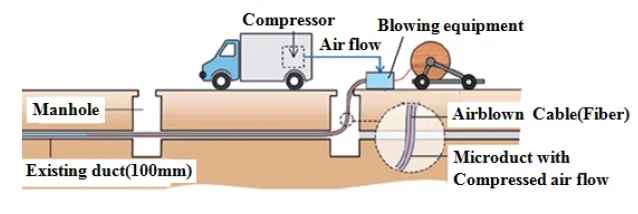Air Blown Fiber Optics

With Air Blown Fiber, customers can install the infrastructure throughout a building and even across the campus without having to over-build their fiber optic system.
Air Blown System enables you to save cost and time
Scale your network immediately, control network capacity, optimize conduit space, meet your bandwidth requirements in minutes, save significant labor and overall project costs, and upgrade your network at the exact pace of emerging technology.
Basic Concept
- Deploying small diameter optical fiber cables in pre-installed tubes by compressed air
- Installation lengths up to 2,000m are achievable (depends on route condition)
- Fast and easy installation of fiber bundle (up to ~40m/min)

Technical Advantages
- Spliceless branching at the tube level
- Rapid fiber installation without the need for heavy machinery
- Stress Free Installation
- Can install current specification fiber for each fiber link
- Easy upgrade or change of fiber type
- Simplified Network planning

In the past pulling was the most popular technique, but the relatively low weight of optical cables has stimulated the development of several new techniques.

The blowing technique is perhaps the most well-known of these new techniques. Experimental work yielded insight into both blowing and pulling techniques. It was discovered that windings in a duct trajectory often contribute more to the force build-up in the cable than bends.
Outside plant personnel are very familiar with the pulling method of installing cable. Thread a line through the duct, attach the line to the cable, and pull or tug the cable through the duct. The force needed to pull the cable usually comes from a capstan or hand -over-hand pulling of the rope. This force is needed to overcome the cable’s frictional resistance to movement. Length of installation is limited by the maximum force allowed on the cable.
Air-assisted installation must overcome the Air same frictional force to move cable, but it does this in a very different way. The force in air blowing first comes from a mechanical device which pushed the cable; and second, from the force of moving air on the cable jacket, or alternatively, the force of air on a piston or carrier at the front end of the cable. This technique allows the air blown cable to “float” inside the Microduct during installation while minimizing sidewall pressures by reducing friction between the cable and the duct wall.